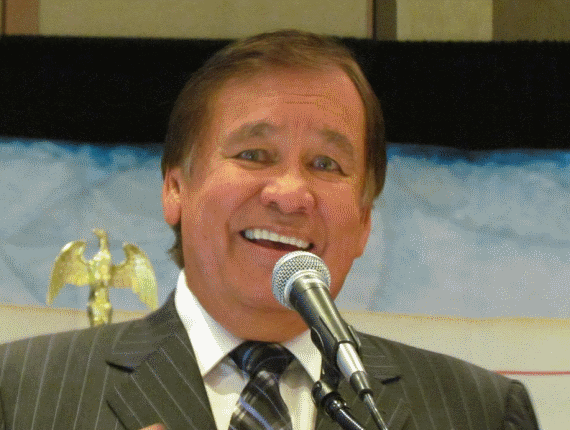Brian Daffron, ICTMN
The “Power Brokers” series travels to the Northwest and West Coast, whose traditional tribal lands house some of the most ethnically diverse cultures in the United States. Yet, among the states along the West Coast and Northwest, there is little representation in state government. Indian Country Today Media Network contacted the administrative offices—as well as legislative assistants—for the states of Alaska, California, Oregon, Washington State, Idaho and Nevada. Among these states, only two—Alaska and Washington—have Native people within its legislative body – an interesting statistic given California is home to the second largest federally recognized tribes within a state at 103, and Nevada is home to more than 20.
Alaska
According to the Environmental Protection Agency website, there are 229 federally recognized tribes, villages and Native village corporations within the state of Alaska. From the 229 tribal governments, the 2012 U.S. Census shows that the American Indian and Alaskan Native percentage is 14.8 percent. The halls of Alaska’s state legislature have six Native members overall—two in the Senate and four in the House.
Senator Lyman Hoffman (D)
Tribal Afflilation: Yupik
Senate District: S
Years in Office: 1991-1992 and 1995-Present
Previous Legislative Experience: Alaska House of Representatives, 1986-1990 and 1993-1994
Committees: Community and Regional Affairs; Fish & Game Subcommittee; Transportation & Public Facilities—Finance Subcommittee; Legislative Centennial Commission; Finance; Governor-Finance Subcommittee; World Trade; Alternate, Legislative Council; Commerce, Community & Economic Development–Finance Subcommittee; Legislature—Finance Subcommittee; Alaska Arctic Policy Commission
Key Legislation: Co-Sponsor, Energy Assistance Program; revision of state brand board
Senator Donny Olson (D)
Tribal Affiliation: Inupiaq (Golovin)
Senate District: T
Years in Office: 2001-Present
Committees: Part of a Republican/Democrat Coalition—One of two Democrats invited within coalition; Finance; Judiciary; State Affairs
Key Legislation: Creation of Native Language Preservation Council; controlled substances classification; legislation concerning U.S. Coast Guard operations in the Arctic; request for U.S. government to open oil and gas exploration in the Arctic National Wildlife Refuge; establishment of Alaska Mining Day; reduction of salmon catch by trawl fishers
Representative Bryce Edgmon (D)
Tribal Affiliation: Choggiung Village Corporation
House District: 36
Years in Office: 2006-Present
Additional Experience: President, Choggiung Village Corporation
Committees: Chair, Subcommittee on Corrections; Chair, Subcommittee on Public Safety; Finance; Subcommittee on Health and Social Services; Alternate, Alaska Arctic Policy Commission
Key Legislation: Change of the terms “mental retardation” and “mentally retarded” in Alaska statutes; act relating to performance reviews, audits and termination of Alaska executive and legislative branches, the University of Alaska and the Alaska Court System; request to the Department of the Interior and Bureau of Land Management to plug legacy well drilling sites; reinstatement of child and adult immunization programs in the state Department of Health and Social Services; renewable energy grant fund; loan for commercial fishing entry permits; act making regional Native housing authorities eligible for grants from the Alaska Housing Finance Corporation; law requiring the Department of Natural Resources to deliver a fishing stream access report to the legislature and governor’s office; Village Safe Water Act
Representative Neal Foster (D)
Tribal Affiliation: Sitnasuak Native Corporation
House District: 39
Previous Experience: Vice-President, Sitnasuak Native Corporation
Years in Office: 2009-Present
Committees: Co-Chair, Military & Veterans Affairs; Community & Regional Affairs; Public Safety-Finance Subcommittee; Judiciary; Transportation & Public Finance Subcommittee; Natural Resources-Finance Subcommittee; Energy
Key Legislation: Legacy well sites; creation of a state food resource development group; opposition to Food & Drug Administration’s findings on genetically-engineered salmon; act relating to performance reviews, audits and termination of Alaska executive and legislative branches, the University of Alaska and the Alaska Court System; revolving bank loan fund; request for United States Congress to adequately fund United States Coast Guard Arctic missions; act making regional Native housing authorities eligible for grants from the Alaska Housing Finance Corporation; law requiring the Department of Natural Resources to deliver a fishing stream access report to the legislature and governor’s office; relocation of the Coastal Villages Region Fund home port; Village Safe Water Act
Representative Charisse Millett (R)
Tribal Affiliation: Inupiaq
House District: 24
Years in Office: 2009-Present
Committees: Co-Chair, Energy; Select Committee on Legislative Ethics; State Affairs; Labor & Workforce Development-Finance Subcommittee; Judiciary; Administration-Finance Subcommittee; Labor & Commerce; Commerce, Community & Economic Development—Finance Subcommittee; Task Force on Sustainable Education
Key Legislation: Vulnerable adult prompt response and notification; Alaska Challenge Youth Academy; police standards; creation of a state food resource development group; commercial use authorization for the Alaska Housing Finance Corporation; legacy well sites; Change of the terms “mental retardation” and “mentally retarded” in Alaska statutes; proclamation of Alaska as a Purple Heart State; opposition to Food & Drug Administration’s findings on genetically-engineered salmon; laws concerning sale and possession of switchblades and gravity knives; encouragement of firearm and firearm accessory manufacture; Alaska Minerals Commission membership; establishment of the Alaska Gasoline Development Corporation; self-defense definitions; establishment of Vietnam Veterans Day; Statewide Suicide Prevention Council; no charge for death certificates of deceased veterans; establishment of Alaska National Guard Day; renewable energy grant fund; authorization of Native housing authorities to receive grants through Alaska Housing Finance Corporation; requirement of Department of Natural Resources to submit report on fishing stream access; urging of U.S. Congress to open coastal plain of Arctic National Wildlife Refuge to oil and gas exploration; opposition to National Oceanic and Atmospheric Administration to create new protected habitat within upper Cook Inlet and Kachemak Bay; prevention, evaluation and liability for concussions in student athletes
Representative Benjamin Nageak (D)
Tribal Affiliation: Inupiaq
House District: 40
Years in Office: 2013
Committees: Co-Chair, Community & Regional Affairs; Education & Early Development—Finance Subcommittee; Health & Social Services; University of Alaska—Finance Subcommittee; Court System—Finance Subcommittee; Energy
Key Legislation: Law regarding abandoned and derelict vessels; legacy well capping; changing of statute language regarding phrases “mental retardation” and “mentally retarded”; opposition to FDA findings on genetically-engineered salmon; establishment of the Alaska Gasoline Development Corporation; allocation of funds to the Special Education Service Agency
Washington
Washington State—the home of Chief Seattle and Sherman Alexie—has 30 federally recognized tribes within its borders, making up 1.8 percent of the state’s total population. Out of 97 members of the Washington House of Representatives, two are Native.
Representative John McCoy (D)
Tribal Affiliation: Tulalip
House District: 38, Position 1
Years in Office: 2003-Present
Committees: Chair, Community Development Housing & Tribal Affairs; Vice-Chair, Environment; Education
Recent Key Legislation: Initiative to increase STEM education; authorization of state-tribal compact schools; protection of state’s cultural resources; Yakima River Basin resource management; access of tribal members to state land; music education initiatives; academic credit for military training; visitation rights for grandparents; Small Rechargeable Battery Stewardship Act; modification Native child care costs; hunting regulations for tribal members; recognition of Native American Heritage Day; regulation of sibling visitation for foster children; excuses of work and school absences for reasons of faith or conscience; increasing capacity of school districts to respond to troubled youth; limiting liability for habitat projects; job order contracting procedure for Department of Transportation; insurance coverage of eosinophilia gastrointestinal associated disorders; initiatives in high school to save lives for cardiac arrests; housing trust fund investments; tribal conservation easements; prohibiting liquor self-checkout machines; high school equivalency certificates; powers and duties of gambling commission; contribution limits to school board candidates; law requiring state to retrocede civil jurisdiction over Indians and Indian territory, reservations, county and lands; creation of state Indian Child Welfare Act; enhancement of Pacific Salmon production; creation of Washington Investment Trust; decommissioning of coal-fired power generators; establishing state-tribal relations; enactment of Middle Class Jobs Act; creation of Clean Energy Partnership; air quality protection; regulation of aviation biofuels production; clarification of rights and obligations of domestic partners in regards to parentage; creation of Indian Education division within office of Superintendent of Public Instruction; bullying prevention; oil spill program requirements; traumatic brain surgery strategic partnership.
Representative Jeff Morris (D)
Tribal Affiliation: Tsimshian
House District: 40, Position 2
Years in Office: 1996-Present
Committees: Chair, Technology & Economic Development; Environment; Transportation
Previous Experience: Speaker Pro Tempore and Floor Leader, Washington House of Representatives
Recent Key Legislation: Joint Center for Aerospace Technology Innovation; business and government streamlining projects; early learning opportunities; wireless communication structures; restriction of crab fishery licenses; extending business and occupation tax credits for research and development; assessment of energy storage systems; using marijuana-related revenue to fund agricultural production research; modification of renewable energy cost recovery program; authorization of small consumer installment loans; stewardship of household mercury-containing lights; scrap metal licensing; renewable energy options for electricity company customers; grandparents’ visitation rights; increase of regulatory oversight for the Office of Minority and Women’s Business Enterprises; renewable energy jobs; elimination of traffic safety cameras; reduction of littering by retail carryout bags; firearm safety funding; tribes and conservation easements; establishment of energy efficiency improvement loan fund; child abuse investigation and proceedings statutes; decommissioning of coal-fired power generators; establishments of energy efficiency standards for consumer products; establishing government-to-government relationship between state and tribes; privatizing management of state ferry system; limits on fertilizer containing phosphorus; defining of municipal solid waste as a renewable resource; procedure of retrocession of civil and criminal jurisdiction over federally recognized tribes; implementation of Blue Alert System; Higher Education Opportunity Act; restriction of television viewers in motor vehicles; expanding rights of domestic partners in regards to parentage; embalmer regulations; improvement of fishing opportunities in Puget Sound and Lake Washington; creation of Indian Education division within office of Superintendent of Public Instruction.
Sources: U.S. Census Bureau; epa.gov; Washington Governor’s Office of Indian Affairs; Open States; and Project Vote Smart
Read more at http://indiancountrytodaymedianetwork.com/2013/08/22/power-brokers-iv-northwest-home-most-tribes-less-legislators-150971






















